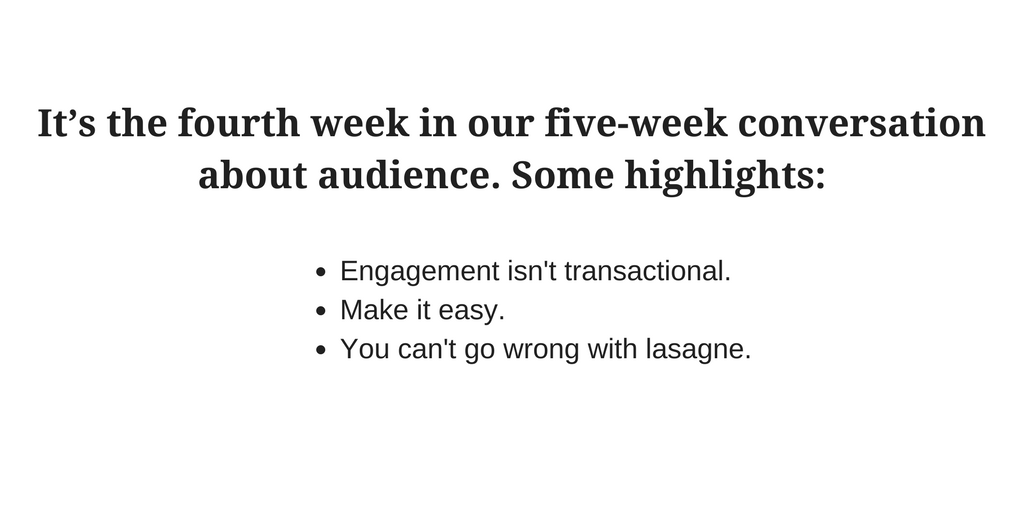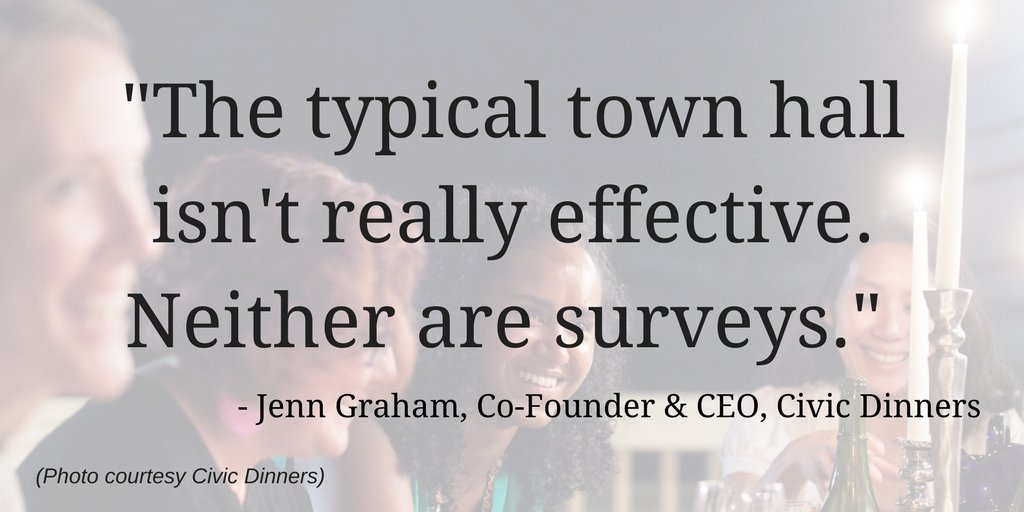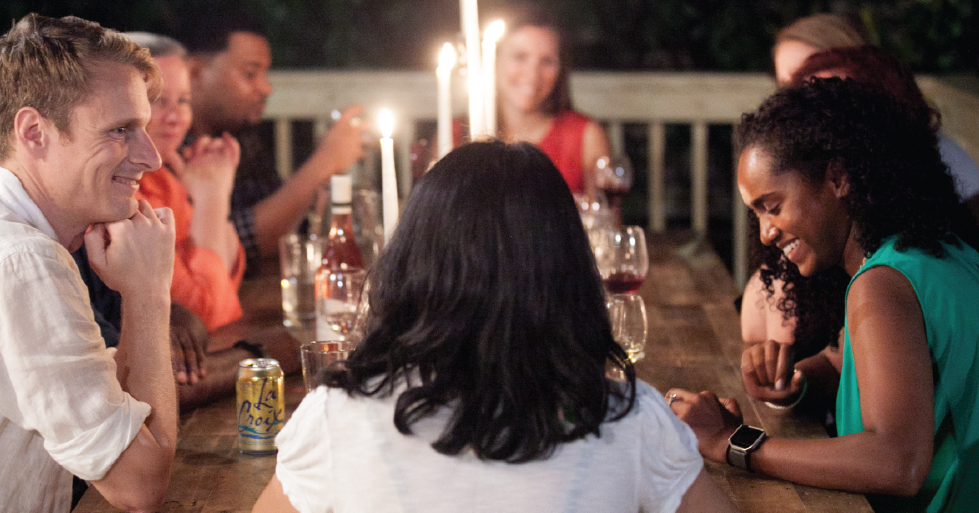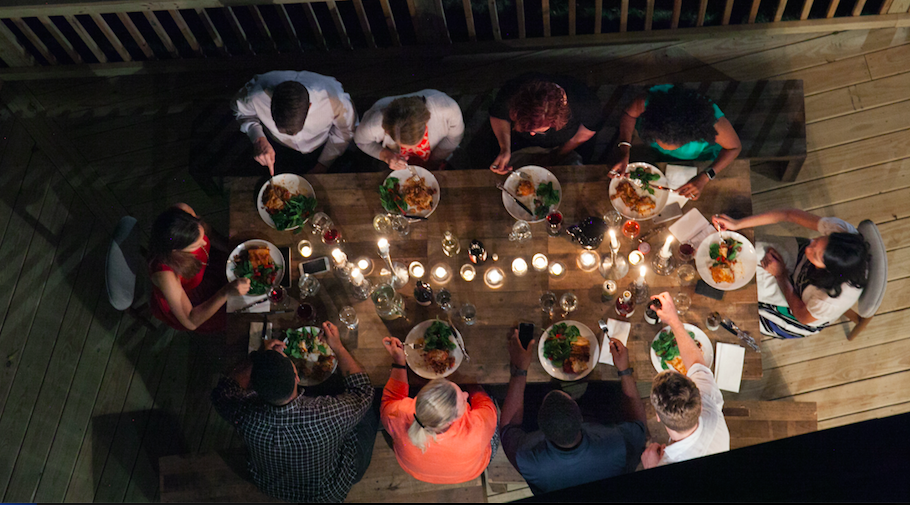This piece originally appeared in Local Edition, our newsletter following the digital transformation of local news. Want to be part of the conversation? You can sign up here.

When Jenn Graham and two friends launched a dinner party project, they wanted to get people in Atlanta talking about what they love about that city.
“And it took off,” Jenn said. “We had 60 dinners in six weeks. It started to spread rapidly and people wanted to know immediately, what’s next? Are our ideas going to be heard by leaders?”
Around the same time, the Atlanta Regional Commission wanted to know what millennials wanted for the future. Jenn brought them the dinner party project.
“It turned into an award-winning community engagement process,” she said. “Government had never used dinner parties as a way to engage their citizens. This is such an old and simple idea.”
Other organizations wanted to have dinners of their own, so Jenn co-founded a platform to bring the whole process together – Civic Dinners.
“The typical town hall isn’t really effective. Neither are surveys,” she said. “This kills two birds with one stone. It helps build a stronger social infrastructure in a community as well as raise awareness around the challenges.”
So far, about 280 Civic Dinners have happened around the world.
I met Jenn at a conference and was fascinated with her stories of gathering strangers for a meal and some mulling. So, when it was time to bring someone who’s not a journalist into this conversation on community, she seemed like the perfect fit. Also, she made a good case for dinner party lasagna, which I’m coming around to.
Our conversation was edited for length and clarity.

Tell us about yourself.
I’m a social innovation designer, which basically means I have a background in graphic design and business strategy. I work mostly with non-profits in the community space where they’re working on collective impact strategies.
I’m fascinated with how design can shape our behavior, our thoughts, our beliefs, and how communication as a forum can do that.
I have a weird background hopping around from business to graphic design and now community engagement.
Tell us about Civic Dinners. What are they?
It’s a super simple concept that was actually birthed by the Jeffersonian Dinners. Way back when, Thomas Jefferson would host these dinners at his house and invite a dozen or so strangers over. He’d pick people from various networks, so it would be farmers and teachers and educators and they’d ask three questions, one question at a time, and allow everyone equal time to share.
So it was an opportunity for not only him to get the pulse of America, but to give everyone else time to learn from one another.
We asked how can we bring this into a more digital space? How can we allow people to have these kinds of conversations to get to know different perspectives, especially considering how polarized our world is now? We’re all in our little bubbles. So being able to come together, no ego, no speaker at the table, everybody has equal time to share their perspective.
We have six to 10 people, generally, three big questions, we provide a host guide, and then the magic happens. The way the questions are designed really help bring out personal stories, common values and possibly a shared vision for the future.
Maybe this is a stupid question, but what do people eat? I can imagine lasagna could get kind of messy. I’d be worried that I had stuff in my teeth the whole time.
Actually, lasagna is my favorite.
We do a classic vegetarian lasagna, you can bake it, you can even do it the night before, then put it in the oven for 15 minutes while you’re putting together a salad and opening up bottles of wine and making some garlic bread and then boom, you’ve got dinner.
More dinners in New Zealand happened in private, in homes, versus in Atlanta where we have about half in restaurants. So people who are busy or don’t have big dining tables to fit six to 10 people can go to a restaurant with a big table set aside that’s quite.
What’s most important is that everyone can hear each other, and also that the food’s not outrageously priced.
Food is honestly secondary to the whole experience. Most people remember the conversation.
You said something earlier about the way you ask questions. Can you tell us more about that?
We use principals of Marshall Ganz’ public narratives. So we try to walk people through an experience starting with a personal story.
The first question’s more of a personal story looking to the past. It’s a chance for you to introduce yourself and give a little bit of insight on who you are. It’s always a question related to the topic. It requires them going back in time and sharing an experience, which really can be quite revealing.
Then the next question goes deeper into values. We’re launching a conversation on livability. So the second question would be, “What are the core tenants of a livable city?” Or “What are the top three things that come to mind when you think of a livable, lovable city?” And we start to identify common themes.
And the third question is to be more future-forward. It’s more about a vision or action. Now that you’ve shared a little bit about yourself and realized what we all have something in common, what can we do? What is the sense of urgency? How can we get more involved in our civic engagement?
It’s helping to narrow down and prioritize but also to think about what role they can play. That way people leave feeling hopeful and powerful.
What have you learned about what doesn’t work with these?
So what doesn’t work, which we learned very quickly in the first pilot, is the way you frame questions can make or break the conversation. We like to start with a positive and end with a positive, and I think in the middle is where you can start to go down a spiral of a vent session. We like to frame questions in a way that can identify barriers without going down deep into the pain points. We want to leave on a high note. That’s rule No. 1.
The other thing is making it so easy for folks. When we talk to people about Civic Dinners, they always love the concept. But then when I ask, hey would you be interested in hosting, they always freeze up.
The way we’ve framed the host guide is it’s super easy to follow, you always get really amazing stories out of them, and people leave really feeling connected.
Can you see a way to have a similar experience to Civic Dinners on the internet and have it not be horrible?
I think it would require some kind of video. We flirted with the idea of doing some kind of hang out session … but it’s tough because we believe there is something magical about breaking bread with people. It’s ingrained in our psyche. It’s part of what makes Civic Dinners special.
I’m sure with the way technology’s going, it will be seamless, but I still think part of the magic is in that face-to-face. We really want people to put their phones aside. While technology can help us bring people together and follow up afterward, we really want this experience to be offline and face-to-face to get down to core issues and really understand each other.
I think before this ongoing conversation on engagement and community, my understanding was you’re doing it because you want X. You want more voices in your story. Or you want a bigger audience. Or maybe you just want to better reflect your audience. What I’m starting to appreciate about journalists doing this work is it’s really just about building a relationship. The payoff is that you’ve built a relationship. Do you have an end goal for these dinners or is it about the relationships?
You nailed it. It’s all about the relationships. I think given the political times we’re in, some people feel like they don’t even know their neighbors or peripheral friends. It’s really an opportunity to bring them to the table and get to know them again on a personal level.
Cities tend to think more transactional and less relationship. People can move anywhere they want. Cities need to do a way better job in building relationships with people and making sure they have trust and mutual respect and ownership of certain projects.
I think relationships can seem a little too fluffy. City planners don’t want to talk about feelings. But really inserting that back into the equations, that’s one of the key things to happiness. It comes back down to the quality of relationships.

Photo courtesy Civic Dinners.
Thanks, Jenn! Next week we’re wrapping up this conversation on engagement (and by we, I really mean we. Stay tuned.)
In the meantime, read this on attention metrics and what they don’t measure, check out LION Publisher’s jam-packed weekly newsletter and Poynter’s News University has a narrative writing on deadline Webinar this Thursday.
See you next week!







